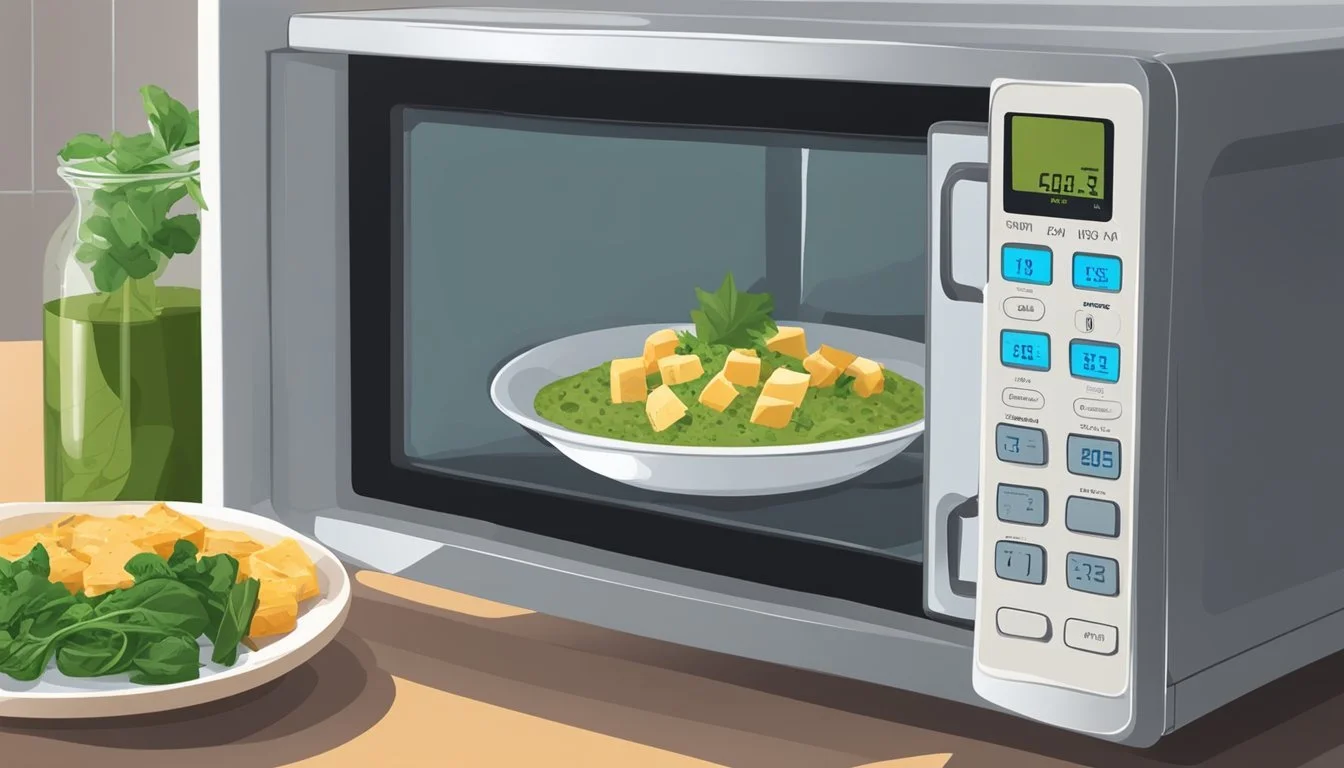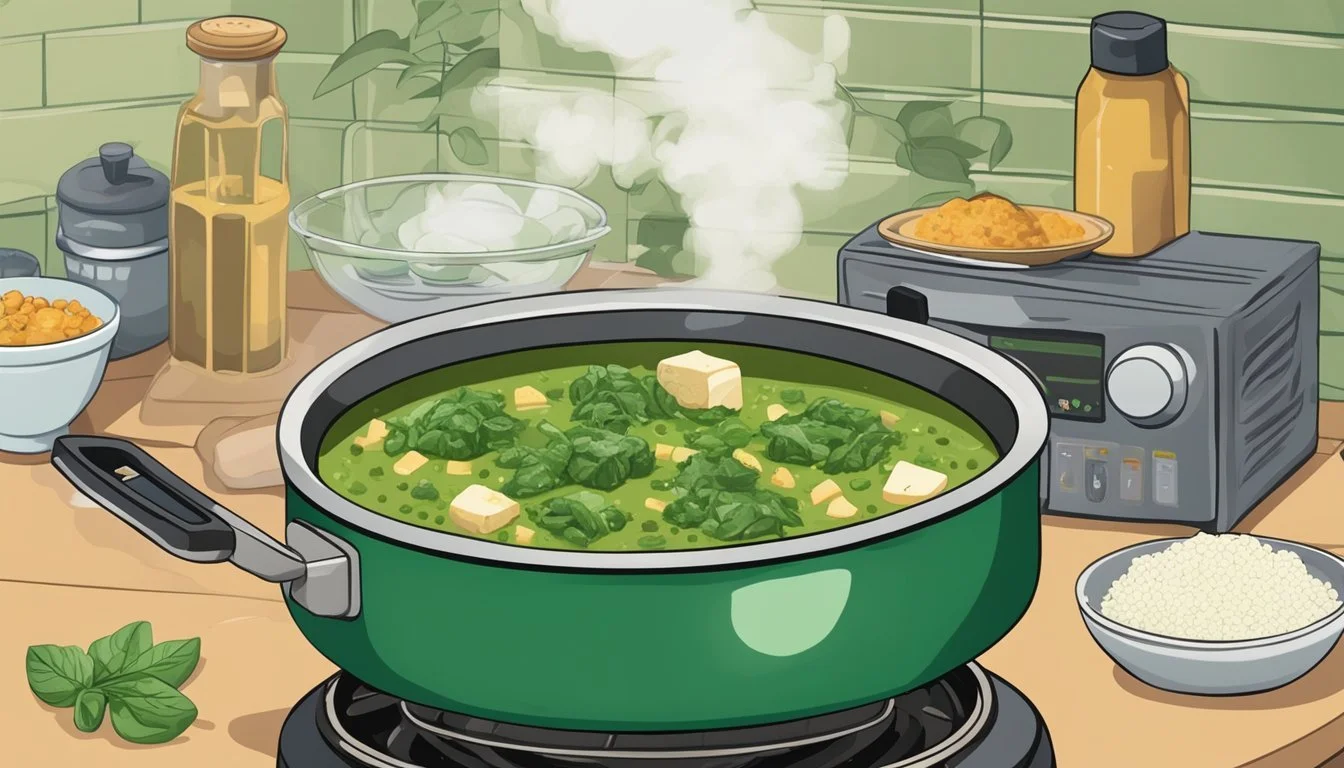How to Reheat Gluten-Free Palak Paneer for Optimal Flavor and Texture
Reheating Gluten-Free Palak Paneer can be an art of its own, ensuring that the dish remains delicious and retains its essential moisture and creaminess. While it’s tempting to simply microwave it, the key to maintaining its flavor and texture lies in a few strategic steps. Place the Palak Paneer in a microwave-safe dish, adding a tablespoon of water to aid in maintaining its moisture, then cover the dish with a microwave-safe lid or a damp paper towel.
This Indian vegetarian dish, renowned for its health benefits, pairs nutrient-rich spinach with chunks of paneer cheese, making it both flavorful and nutritious. An alternative reheating method can involve using the stovetop, which some find helps to preserve the dish’s texture better. Heat it gently over medium heat, adding a splash of water or milk to the pan and stirring occasionally to mimic the fresh, creamy consistency it had when first prepared.
Indian food enthusiasts know the importance of preserving the authentic taste of dishes like Palak Paneer. Those who enjoy this gluten-free and healthy meal can confidently reheat it, knowing that with the right techniques, the delightful flavors and textures will not be lost. This article will guide through each method in detail to ensure your Palak Paneer tastes just as good the second time around.
Understanding Palak Paneer
Palak Paneer is a popular North Indian dish made from spinach and cottage cheese, often enjoyed for its rich flavor and nutritional benefits. It can be adapted to fit various dietary needs, including gluten-free, vegetarian, and vegan diets.
Origins and Popularity in India
Palak Paneer has its roots in North Indian cuisine, particularly in Punjab. This dish combines palak (spinach) and paneer (a type of Indian cottage cheese) to create a meal that is beloved across India and internationally. It is often served with rice or bread such as naan or roti. Over time, its creamy texture and balanced flavors have made it a favorite in Indian homes and restaurants alike.
Nutritional Profile
Palak Paneer is not just delicious but also nutritious. Spinach, a core ingredient, is rich in vitamins A, C, and K, as well as folate and iron. Paneer adds a substantial amount of protein and calcium, making the dish a well-rounded nutritional choice. Together, these ingredients provide essential nutrients that support overall health, including strong bones and a robust immune system.
Gluten-Free Considerations
Palak Paneer is naturally gluten-free, provided no gluten-containing ingredients or contaminants are introduced during preparation. Spinach and paneer are both free from gluten. However, cross-contamination can occur, particularly in restaurants or when paired with gluten-containing bread such as naan. For those with gluten sensitivity or celiac disease, it's crucial to ensure all ingredients and utensils are gluten-free.
Vegetarian and Vegan Variations
Traditionally, Palak Paneer is a vegetarian dish since it includes dairy-based paneer. For a vegan option, tofu can be used instead of paneer. Spinach remains the primary ingredient in both versions, retaining similar texture and flavor. To make the dish vegan, coconut milk or cashew cream can replace dairy cream for added creaminess, ensuring that no animal products are used.
Essential Ingredients and Substitutes
To prepare a delicious gluten-free Palak Paneer, it's important to understand the ingredients used and their possible substitutes, particularly for those needing vegan and gluten-free options. These elements ensure that the dish maintains its traditional flavors and textures while accommodating dietary restrictions.
Key Ingredients
The primary ingredient in Palak Paneer is fresh spinach. This leafy green should be blanched and pureed for a smooth consistency. Paneer, a mild Indian cheese, is typically cubed and sautéed. Onions, tomatoes, garlic, and ginger provide the aromatic base, while garam masala, cumin seeds, turmeric, and salt enhance the flavor profile. Oil is used for sautéing, and a splash of cream adds richness.
Gluten-Free Alternatives
To ensure the dish is gluten-free, avoid using any spice blends that may contain wheat. Stick to pure spices like cumin seeds, turmeric, and garam masala. For thickening, which is not always necessary but can be used, opt for gluten-free alternatives such as cornstarch or arrowroot powder instead of wheat flour. Ensure that any accompanying sides, like naan, are made from gluten-free flours such as rice flour or almond flour.
Vegan Substitutes
For a vegan version of Palak Paneer, replace paneer with tofu or cottage cheese. Tofu, when cubed and lightly fried, mimics the texture of paneer well. To maintain creaminess without dairy, use coconut milk or cashew cream. Similarly, sautéing ingredients in vegetable oil rather than ghee keeps the dish vegan. Nutritional yeast can provide a cheesy flavor if desired.
Preparation Before Reheating
Proper preparation is key to preserving the texture and flavor of gluten-free Palak Paneer. Ensuring leftover storage and thawing are done correctly will guarantee a delicious meal upon reheating.
Storing Leftovers
To store Palak Paneer leftovers, place them in an airtight container. This helps maintain the dish’s moisture and prevents contamination. Make sure to label the container with the date. Consume refrigerated leftovers within 3-4 days to ensure freshness. For longer storage, freezing is an option. Divide the Palak Paneer into portions before freezing to make reheating more manageable.
Thawing Frozen Palak Paneer
When ready to reheat, transfer frozen Palak Paneer from the freezer to the refrigerator. Allow it to thaw overnight. If pressed for time, use the defrost setting on a microwave in short bursts, stirring in between. Avoid using high heat to prevent altering the texture. Once thawed, proceed with reheating using your preferred method.
Reheating Techniques
Reheating gluten-free Palak Paneer can be approached using the stovetop, microwave, or oven, each having its particular steps to ensure the dish remains flavorful and moist. The following methods outline each technique in detail.
Stovetop Method
Reheating Palak Paneer on the stovetop is simple and effective.
Start by heating 1-2 tablespoons of oil or adding a splash of water in a nonstick pan over medium heat. Place the Palak Paneer in the pan, stirring occasionally to prevent sticking. Add a splash of water or cream to maintain moisture.
Heat for 5-7 minutes, ensuring the paneer does not dry out and the spinach retains its creamy texture. Once heated evenly, remove from heat and serve immediately.
Microwave Method
The microwave method is easy and convenient for those needing a quick reheating solution.
Place the Palak Paneer in a microwave-safe dish. Add a tablespoon of water to help maintain its moisture. Cover the dish with a microwave-safe lid or a damp paper towel to prevent drying out.
Heat on medium power in 30-second intervals, stirring in between to distribute heat evenly. This process helps to preserve the creaminess and flavor of the paneer and spinach. Heat until the dish is warm throughout.
Oven Reheating
Reheating in an oven is ideal for those who prefer an even and gentle reheating process.
Preheat the oven to 350°F (175°C). Transfer the Palak Paneer to an oven-safe dish. Add a splash of water or cream to maintain moisture. Cover with aluminum foil to prevent drying.
Bake for approximately 20 minutes or until heated through. Stir halfway to ensure even heating. Once done, remove from the oven and serve while hot.
These techniques ensure that the Palak Paneer stays moist, creamy, and flavorful during the reheating process.
Health and Nutrition
Palak Paneer is both flavorful and nutritious, making it a staple in many gluten-free diets. It balances essential nutrients, offering several health benefits while maintaining dietary preferences.
Calorie and Macro Breakdown
Palak Paneer typically provides a moderate calorie count, making it an excellent choice for those monitoring their intake. A single serving often contains around 200-300 calories.
Main Macronutrients:
Protein: Paneer is a key protein source, delivering around 10-15 grams per serving.
Carbohydrates: Primarily from spinach, it offers approximately 10-15 grams, with minimal sugars.
Fats: Contains 15-20 grams, including saturated fats; paneer contributes the majority.
Palak Paneer is also rich in dietary fiber from spinach, aiding digestion and overall gastrointestinal health.
Balancing a Healthy Diet
Incorporating Palak Paneer into a balanced diet ensures a good mix of nutrients. Pairing this dish with whole grains like brown rice or gluten-free naan enhances the fiber and carbohydrate content.
Key Nutritional Highlights:
Vitamins and Minerals: Spinach is a powerhouse of vitamins A and C, iron, and calcium.
Sodium and Cholesterol: Be mindful of sodium levels, especially if store-bought or heavily seasoned. Opt for low-sodium recipes when possible.
Balancing fats, especially by choosing low-fat paneer or adjusting the use of oil, helps manage saturated fat intake. Reducing saturated fats can benefit heart health without sacrificing taste or nutrition.
Additional Tips and Tricks
To ensure re-heated gluten-free Palak Paneer maintains its authenticity and flavor, consider these tips on enhancing flavor, adjusting texture, and exploring alternative cooking methods.
Enhancing Flavor
When reheating Palak Paneer, coconut oil can be used instead of traditional oils to add a unique flavorful twist. Incorporating extra dried fenugreek leaves or cashew cream can enhance the creaminess and depth of flavor.
A touch of sea salt can make a significant difference. Adding a bit of freshly ground spices like garam masala or cumin just before serving can boost the dish’s aromatic profile.
If you enjoy a spicy kick, sprinkle some red chili powder or diced green chiles.
Adjusting Texture
To maintain the creamy texture of Palak Paneer, adding a small amount of coconut milk or cashew cream during reheating helps in keeping the dish from drying out.
Use a blender or food processor to achieve a smoother consistency if it becomes too chunky. Stirring finely crushed cashews or diced tomatoes into the dish can provide additional texture and richness.
Ensure stirring frequently to prevent any ingredients from sticking to the pan.
Alternative Cooking Methods
Using different reheating methods can affect both texture and flavor. Microwaving is quick and convenient: placing the Palak Paneer in a microwave-safe dish with a dash of water and covered with a damp paper towel helps preserve moisture. Heat in short intervals, stirring in between.
For a more authentic reheating method, consider heating on a stovetop over medium heat. Use avocado oil for a healthier option and gently stir until heated evenly. Oven reheating can also be effective; place it in a covered oven-safe dish at 300°F for about 10-15 minutes.
These methods ensure the dish retains its cheesy and flavorful essence.






